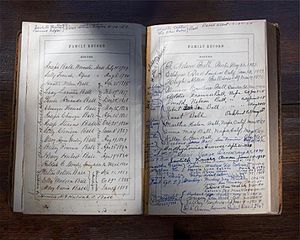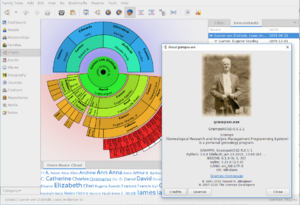Genealogy facts for kids

Genealogy is the study of your family's history. It's like being a detective, tracing back through time to find out where you come from. You discover who your ancestors were and what their lives were like. This journey can be very rewarding, helping you connect with your heritage. It also teaches you about the people who shaped your family's story over many years.
A record of this family history work can be called a "genealogy," a "family history," or a "family tree." Sometimes, a "genealogy" or "family tree" shows the children and grandchildren of one person. A "family history" usually traces the parents and grandparents of one person. But often, these terms are used to mean the same thing. A family history can also include fun facts, family traditions, and stories.
Contents
Why explore your family history?
Exploring genealogy can be a fun and educational activity for young people. It helps you understand your roots and appreciate different cultures. It also helps you develop important research skills. By learning about your ancestors' experiences, you can better understand historical events. You'll see how these events impacted families, including your own.
How to research your family tree
Genealogists usually start by gathering family documents and stories. This creates a base for their research. Then, they look at historical records to find clues about ancestors and other relatives. They try to find out about family connections and important life events. Genealogists usually work backward in time, starting from the present. To keep track of everything, they use family group sheets and pedigree charts. These can be handwritten or made with special computer programs.
Sharing your family research
Most genealogy software programs can share information in a special format called a GEDCOM. This stands for GEnealogical Data COMmunication. This format lets you share your family tree with other genealogists. You can also add it to online databases or create family websites.
Many websites let people share their family trees online. Members can upload their trees and connect with other family historians. This helps them fill in missing parts of their research. There are also other online places where genealogists connect and share information.
Helping others with genealogy
Many people help each other with genealogy for free. This can be very informal or very organized.
Informal help includes online message boards and email lists. These are for specific family names, regions, or other topics. You can use these forums to find relatives, ask for help finding records, or get research advice. Many genealogists also work together on projects. Some projects create lists of names from old records, like probate cases. These lists help others find the original records. Other projects copy or summarize records.
Some volunteers offer to look up records or take photos in their local areas. They do this for researchers who cannot travel there themselves.
If you want a more organized way to help, you can join a genealogical society. There are thousands of these societies worldwide. Most focus on a specific family name, ethnicity, or geographic area. Genealogical societies are mostly run by volunteers. They might have libraries, publish newsletters, help the public with research, or offer classes. They also organize projects to save or copy old records.
Genealogy software
Genealogy software helps you collect, store, sort, and show your family history data. At a minimum, these programs hold basic facts about people. This includes their births, marriages, and deaths. Many programs also let you add more details, like jobs, places they lived, and notes. Most also help you keep track of where you found each piece of information.
Most programs can create basic family charts and reports. They also let you add digital photos. You can also export your data in the GEDCOM format. This means you can share your information with people using different genealogy software. More advanced features include keeping private information about living people hidden. Some programs can also add sound files, create family history books, or build web pages. They can also help you search the internet for more data. Some programs are made for specific religions or ethnic groups.
Records and documents for research

Genealogists use many different types of records in their research. To do good research, it's important to know how these records were made. You also need to know what information they contain and how to find them.
Common types of records
Here are some types of records used in genealogy research:
- Vital records
- Birth records
- Death records
- Marriage and divorce records
- Adoption records
- Biographies (life stories)
- Cemetery lists
- Census records (counts of people)
- Church and Religious records
- Baptism or christening
- Brit milah or Baby naming certificates
- Confirmation
- Bar or bat mitzvah
- Marriage
- Funeral or death
- Membership lists
- City and telephone directories
- Coroner's reports (about deaths)
- Court records
- Criminal records
- Civil records
- Diaries, personal letters, and family Bibles
- DNA tests
- Emigration, immigration, and naturalization records (about moving countries)
- Land and property records, deeds (about ownership)
- Military and conscription records (about army service)
- Newspaper articles
- Obituaries (death notices)
- Occupational records (about jobs)
- Oral histories (spoken stories)
- Passports
- Photographs
- Poorhouse, workhouse, almshouse, and asylum records (about places for the needy or sick)
- School and alumni association records
- Ship passenger lists
- Social Security (in the US) and pension records (about retirement money)
- Tax records
- Tombstones, cemetery records, and funeral home records
- Voter registration records
- Wills and probate records (about what happens after someone dies)
To keep track of people, governments started keeping records. These records were for everyone, not just royalty or nobility. For example, in England, parish registers began in the 1500s. As more people were recorded, there were enough records to follow a family. Important life events, like births, marriages, and deaths, were often written down. Genealogists find these records in local, regional, or national offices or archives. They use them to find information about family relationships and create a timeline of people's lives.
Images for kids
-
12 generations of a Hindu Lingayat male's family from central Karnataka over 275 years
-
A Medieval genealogy traced from Adam and Eve
-
The Family History Library, run by The Church of Jesus Christ of Latter-day Saints, is the world's largest library for genealogy.
See also
 In Spanish: Genealogía para niños
In Spanish: Genealogía para niños









